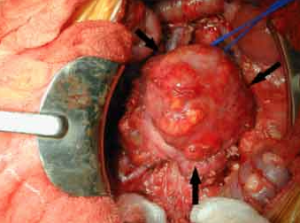Treatment with Unituxin (Dinutuximab) for high-risk neuroblastoma in children recommended by EMA

Last Updated on June 7, 2015 by Joseph Gut – thasso
June 06, 2015 – On May 22, 2015, the European Medicines Agency (EMA) has recommended granting a marketing authorisation for Unituxin (Dinutuximab) for the treatment of high-risk neuroblastoma, a type of cancer that most often occurs in young children. Unituxin (Dinutuximab) is to be used in children who have responded to an induction treatment with chemotherapy, followed by myeloablative therapy and autologous stem-cell transplantation.
Neuroblastoma is a rare cancer that forms from immature nerve cells. It is usually seen as a lump in the abdomen or around the spine and typically occurs in children under five years of age. In many cases it is present at birth, but is diagnosed only

later when the cancer has already spread to other parts of the body and the child begins to show symptoms of the disease. Patients with neuroblastomas classed as ‘high risk’ have a lower survival rate than for other neuroblastomas, and Unituxin provides a much-needed treatment option to prolong survival in this group of patients.
Unituxin (Dinutuximab) is a monoclonal antibody (a type of protein) that has been designed to recognise and attach to a specific structure (an antigen) called disialoganglioside (GD2), which is present in high amounts on the surface of neuroblastoma cells, but in lower amounts in normal cells. When the medicine attaches to the neuroblastoma cells, it marks them out as targets for the body’s immune system, which is then expected to attack the cancer cells and thereby reverse or slow down the progression of the disease.
The safety and efficacy of Unituxin (Dinutuximab) were evaluated in a clinical trial in children with high-risk neuroblastoma who had already responded to chemotherapy (at least a partial response) and were further treated with myeloablative therapy and autologous stem-cell transplantation. The study randomly assigned 230 patients to receive Unituxin (Dinutuximab) combined with other immunotherapy (GM-CSF and IL-2) and an oral retinoid medicine (isotretinoin) or isotretinoin alone. After two years, 66% of patients receiving the Unituxin combination were alive and free from recurrence or tumour growth, while this was the case in only 48% of patients treated with isotretinoin alone during the same time period. Unituxin (Dinutuximab) is to be administered in combination with granulocyte-macrophage colony-stimulating factor (GM-CSF), interleukin-2 (IL-2), and isotretinoin.
The most common side effects of Unituxin (Dinutuximab) are pain, allergic reactions and hypotension (low blood pressure). Because GD2 is also present on normal nerve cells, Unituxin (Dinutuximab) causes irritation and severe pain of the nerve cells. It is therefore recommended that pain relief is given before and during treatment with Unituxin (Dinutuximab). Despite prophylaxis, two thirds of children experience pain and about 40% experience severe pain. The Committee for Medicinal Products for Human Use (CHMP) recommended that the safety profile of Unituxin (Dinutuximab) be further assessed post-authorisation and required the company to include this in their risk management plan for Unituxin.
Because neuroblastoma is rare, Unituxin (Dinutuximab) received an orphan designation from the Committee for Orphan Medicinal Products (COMP) in 2011. Orphan designation and the associated incentives such as fee reductions for scientific advice are among the Agency’s most important instruments to encourage the development of medicines for patients with rare diseases. The opinion adopted by the CHMP at its May 2015 meeting is an intermediary step on Unituxin’s path to patient access. The CHMP opinion will now be sent to the European Commission for the adoption of a decision on an EU-wide marketing authorisation. Once a marketing authorisation has been granted, each Member State will take a decision on price and reimbursement based on the potential role/use of this medicine in the context of its national health system.

